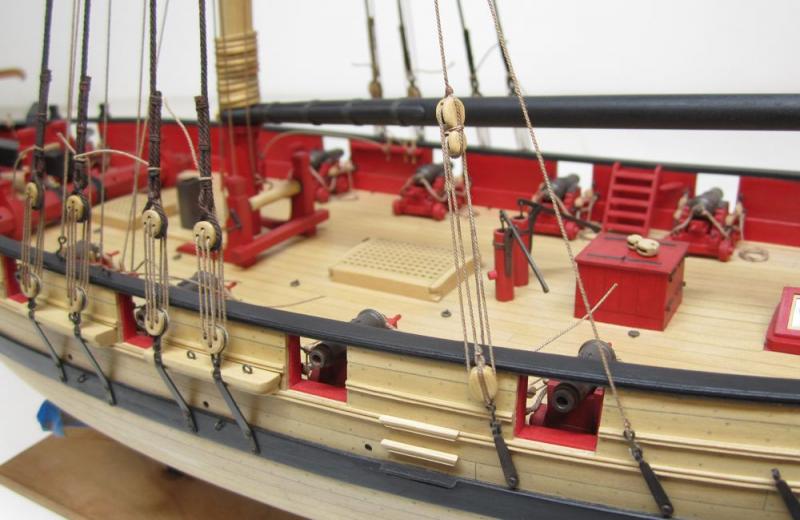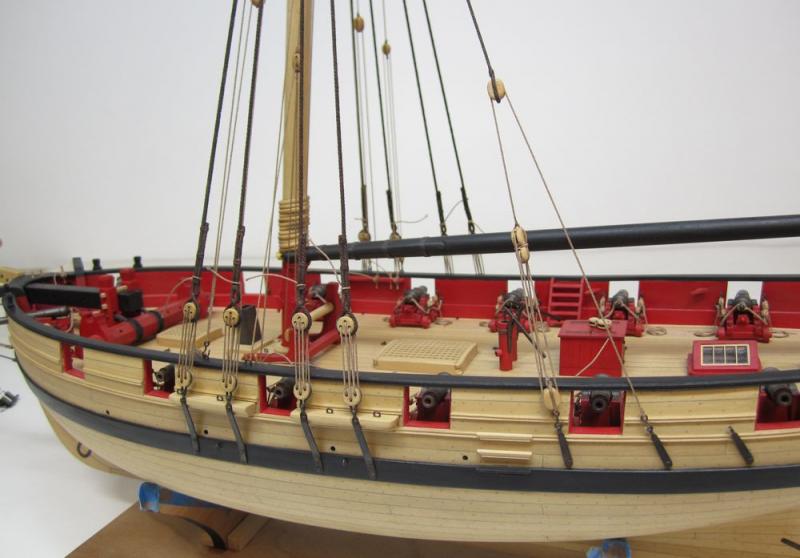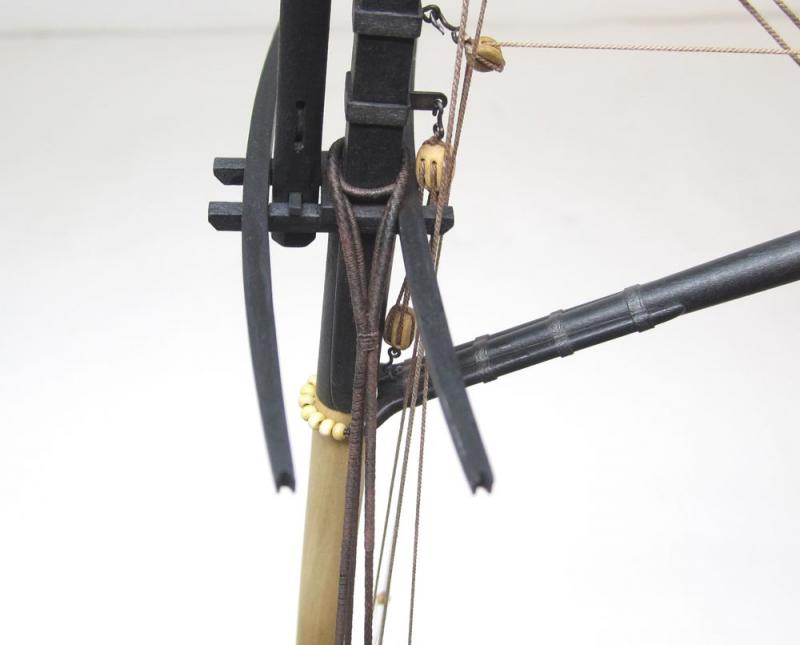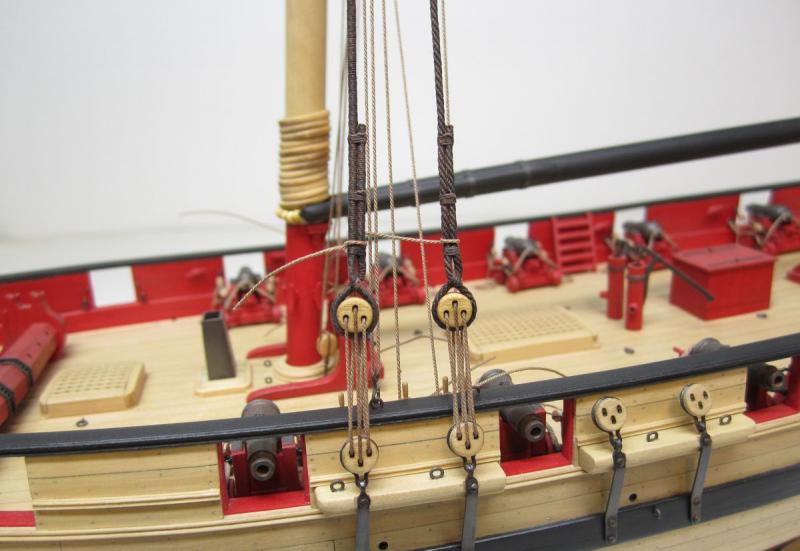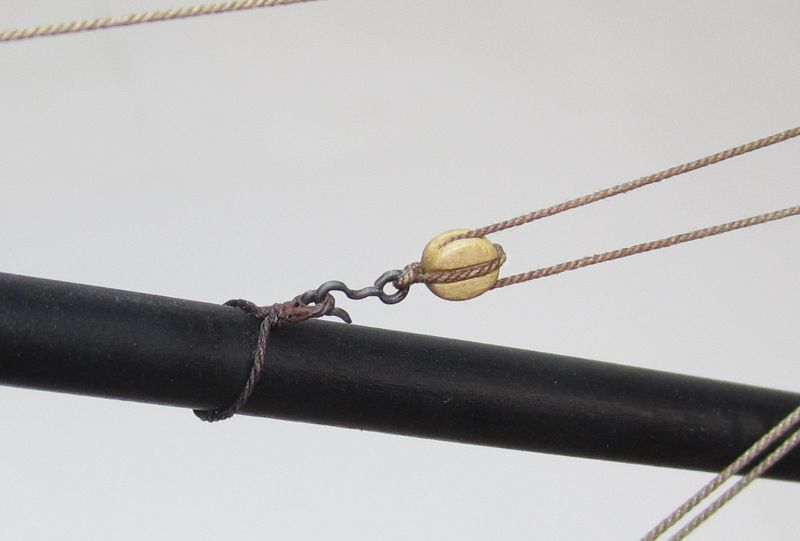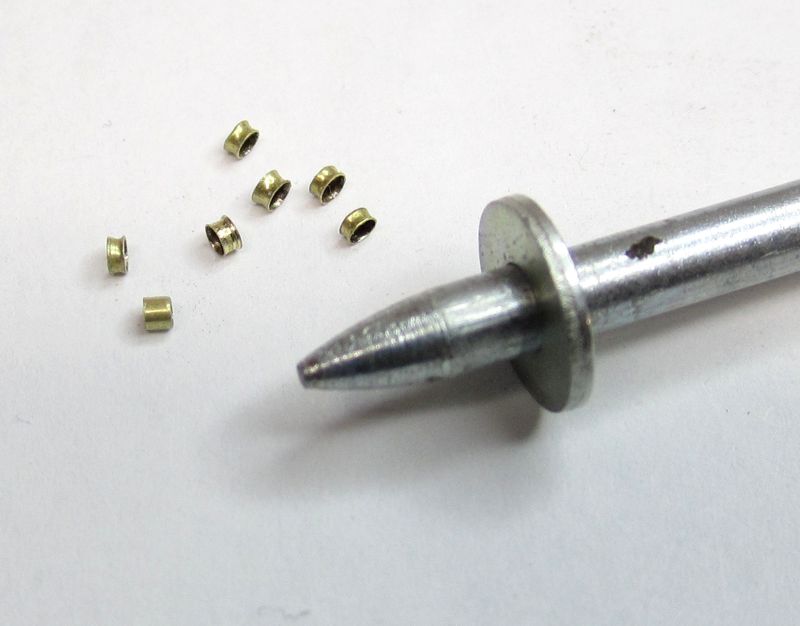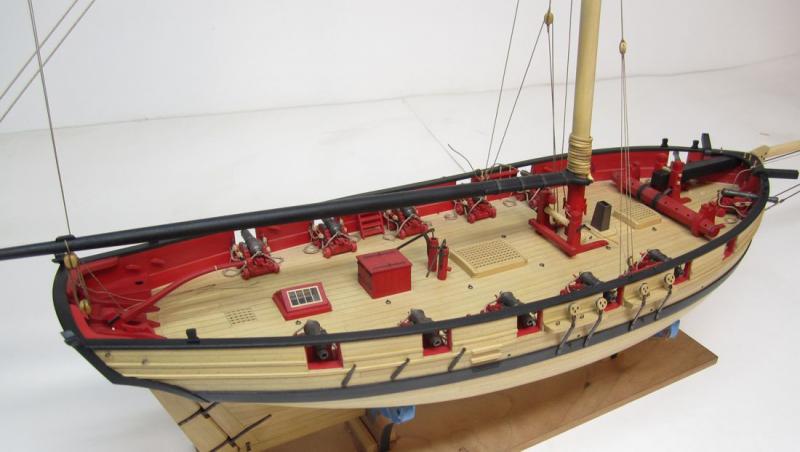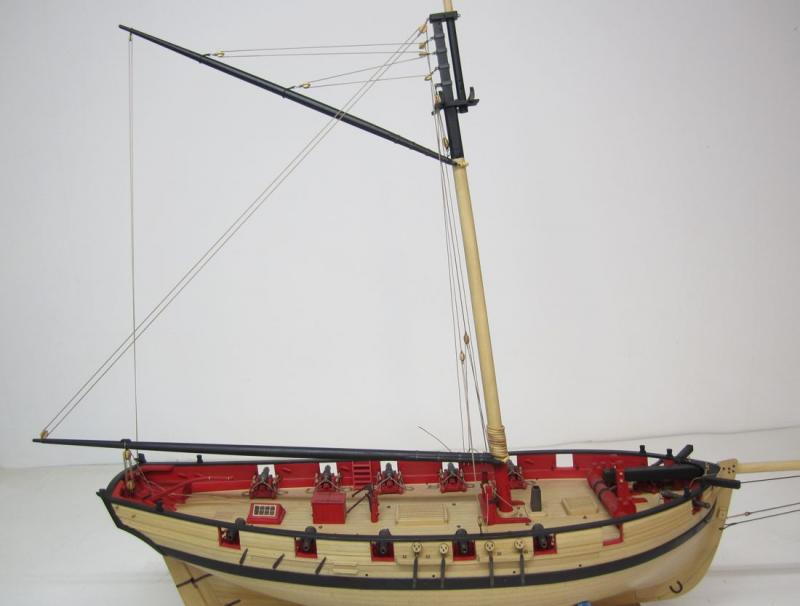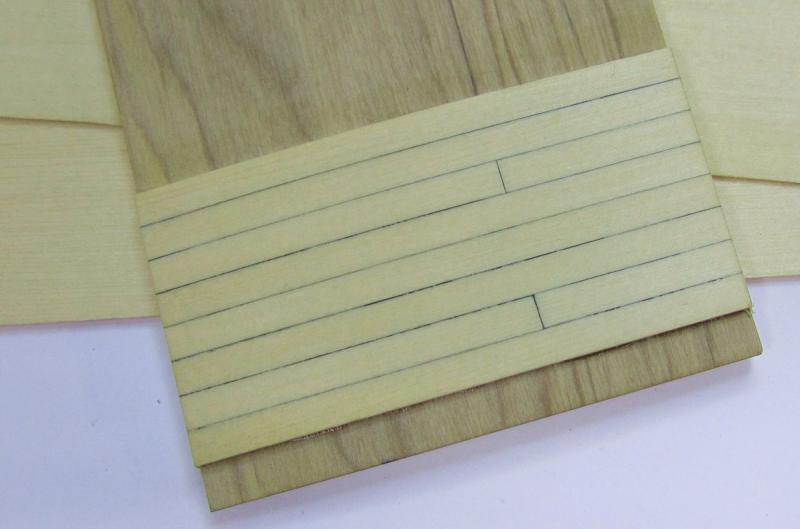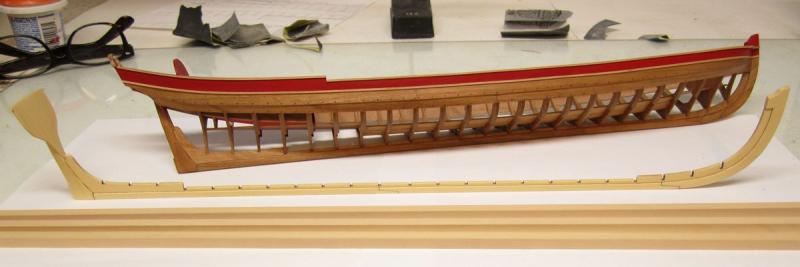-
Posts
9,504 -
Joined
-
Last visited
Content Type
Profiles
Forums
Gallery
Events
Everything posted by Chuck
-
That is something I would not recommend. Eventually they will get brittle and break. Its just not something you see on ship models and it would adversley effect the look and texture of the rope.
-
As a rule....I dont glue any of my lines to their final belaying point. They are made fast to their pins and cleats but because it is inevitable that you will need to re-tension the lines, this makes it very easy to do. There is no really good reason to glue the line permanently. It will stay in place just fine and makes fixing the lines or even replacing them much easier later on. I have restored models that are over 100 years old and they rarely glued the ropes to the belaying points back then. This meant it was as simple as pulling a belaying pin and re-doing it with proper tension. No need to cut anything. It was a pleasure compared to models which had the ropes glued and hard to work. I am currently rigging my model and have routinely adjusted the tension on many lines as it progresses. Once completed I will add rope coils over the pins with the smallest dot of white glue. They will be easy to remove if needed later. And the line can be adjusted as described.
-
Shrouds are completed. I also added the lower backstay on the port side. The fiddle block is a min-kit from Syren (13/32"). You can see another one on top of the companionway which will be used for the other side. It is built up from three laser cut layers. Here is a shot of the growing shroud gang. The aft pair as well as the lower backstay are served only along the top that goes around the mast head. They are served down to a bit below the cheeks. Once that is finished it will be time for the sling for the lower yard and then the main stay.
- 1,051 replies
-
- cheerful
- Syren Ship Model Company
-
(and 1 more)
Tagged with:
-
No I like to pop in and look at as many builds as possible when time permits. I might not say much but I enjoy watching everyones progress. You are doing a fine job.
- 96 replies
-
- topsail schooner
- revenue cutter
-
(and 3 more)
Tagged with:
-
If you click on each size of my Syren blocks it will tell you which size rope is best for those sizes of blocks.
- 96 replies
-
- topsail schooner
- revenue cutter
-
(and 3 more)
Tagged with:
-
Thanks. Yes Druxey I have tried it that way but old habits die hard. I am just most comfortable doing it this way. Its not too bad but just a bit finicky. Luckily there are only eight to do. But I am happy with how they turned out. Chuck
- 1,051 replies
-
- cheerful
- Syren Ship Model Company
-
(and 1 more)
Tagged with:
-
Thanks...I will say this this, its a joy working in 1/4" scale. You dont have to fight with such tiny parts and you get more detail. But you have to have the room to work and display it. Luckily this model is not that large since its just a cutter. I will have to find a good home for it once its done though...not much room to display the finished cased model.
- 1,051 replies
-
- cheerful
- Syren Ship Model Company
-
(and 1 more)
Tagged with:
-
Thank You very much, and happy Thanksgiving. I rigged the Burton Pendants and started the shrouds. The Burton Pendants (.035 dark brown) are served the entire length with a 1/4" single block seized on it end. It hangs down from the trees a bit more than we are used to with a typical frigate. Then a tackle was set up to the pendant. The tackle is only shown on a few contemporary models and I thought it was interesting so I decided to show it. This particular version is based on the cutter model in the London Science museum and Peterson's book. The Shrouds are pretty standard, I used .045 dark brown rope. The forward shroud is served its entire length. The serving was all done on the "Serv-o-matic". The remainder of the shrouds will only have the portion around the mast head served down to just below the cheeks. Below you can see my shroud gang taking shape with this first pair of shrouds done. The deadeyes were turned in and set-up with the usual methods. I dont particularly care for this aspect of rigging. Especially getting that first seizing done just above the deadeye. Its an awkward one as its oriented differently but it is important because it creates that shape of the shroud doubling you strive for. The lanyard was rigged with .018 light brown rope and not glued permanently. This was done once again so I can easily re-tension the shrouds after all the standing rigging is completed. Now to finish up the three remaining pairs.
- 1,051 replies
-
- cheerful
- Syren Ship Model Company
-
(and 1 more)
Tagged with:
-
Cherry and Maple sheets and milled strips are now available. I know this because I am building his site for him.....I bartered for wood. He isnt the kind of guy to build his own so I am taking care of it for him and you probably notice the similarity to my own. Anyway....as he gives me new updated wood info and availability I will add them to the WPS website and let you guys know. I hope you give them a try. Chuck
-
Thank You guys. The thimbles are made from thin wall brass tube. In this case 1.5 mm brass tube. I tap them with a blunt point as shown in this image. Not to hard. The brass is soft and the thimbles will tear. They will also stretch larger in dia. and become thinner than you cut the original length. Here are some close ups of my thimbles thus far in use on the model. Also note the thimble not yet punched to flare its ends in that first photo. See how much longer and smaller it is. Hooks are shaped from 26 gauge black wire. Chuck
- 1,051 replies
-
- cheerful
- Syren Ship Model Company
-
(and 1 more)
Tagged with:
-
Finished rigging the gaff today. Nothing unusual or interesting about doing this. It was fun and I basically created the gaff just like the boom. One interesting feature to point out might be how the blocks are hooked to thimbles/bullseyes on the gaff. The blocks were not just seized to the gaff. This follows a method I saw on another cutter from the time period. Just seemed more interesting than doing it the other way. It has gotten harder to photograph now. Its a much bigger subject to get in frame. Next up will be the pendant tackles and shrouds....none of the falls or loose ends have been glued to their belaying points yet. You can see them left a bit long on deck. They are just made fast to each belying point and can be undone easily. I did this just in case they have to be retensioned after the shrouds and stays are completed. Some lines have a tendency to go slack as rigging progresses. Chuck
- 1,051 replies
-
- cheerful
- Syren Ship Model Company
-
(and 1 more)
Tagged with:
-

MS Fair American rigging plan leaves alot to be desired.
Chuck replied to JPAM's topic in Masting, rigging and sails
Check out the gallery which has many photos of that contemporary model. http://modelshipworld.com/index.php/gallery/album/448-fair-american-rogers-collection-annapolis/ -
They are in central New Jersey. They dont have a physical store. He is a member of the a tree commission or conservany or something and gets a lot of his wood from those operations. For example, after Hurricane Sandy he collected a ton of Dogwood, Cherry, and Pear and apple...from fallen trees. Also has dealings with the local tree farmers and orchards. Chuck
-
Pat That looks fantastic. It must be bitter sweet after working on her for so long. That is a fine looking model.
- 517 replies
-
- Endeavour
- Artesania Latina
-
(and 1 more)
Tagged with:
-
Please welcome and thank Wood Project Source for becoming a sponsor of Model Ship World. WPS supplies milled wood sheets and strips along with carving blocks for many hobbies. Their specialty is Alaskan Yellow Cedar Sheets and Carving Blocks. Other species like Yellow Heart, Purple heart, Butternut, Applewood, Dogwood and Mahogany are soon to follow. They also carry the staples for our hobby like Boxwood, Swiss Pear and others. They are just finishing up their new website so please have some patience with them as they continue adding more wood species and products to their online store. They have many more than I listed. I have personally bought from them many times as they are close by and I gotten to know the owner. I have bought some Yellow Cedar and Boxwood from them and will say that I am very happy with the quality of the wood. They have fantastic prices and they are the lowest I have seen for some wood sheets. Please join me in welcoming them as a sponsor of MSW. Visit their site and check them out. I am grateful they decided to become a sponsor and didnt hesitate after I asked them about it. www.woodprojectsource.com
-
Thank you so much guys....
- 1,051 replies
-
- cheerful
- Syren Ship Model Company
-
(and 1 more)
Tagged with:
-
Heres a close up of my planking experiment with Yellow cedar. Very tight almost inconceivable grain. holds a sharp edge and no need to stain it. There are two 1/32" sheets below it that I will cut a few carving blanks from and give it a try. I just have to find some time to do so. I applied one coat of WOP. The seams were simulated with a #2 pencil. I like it. I havent tried making frames but it is certainly a great replacement for planking....either for boxwood or even holly. It will darken over time. ALSO....its about half the price of Boxwood and Holly (give or take). A bit more than Cherry or Maple but I think its a much better wood. It really does cut like butter with a #11 blade. Hopefully the same will be true when I carve it. Chuck
-
I am going to try and carve one of the blanks from Yellow Cedar. Its beautiful stuff and I just got some from my supplier. In case you want to try it check out his site. He also mills boxwood and a whhole bunch of other stuff. His prices are fantastic. So far I am more than happy with the quality and respoinsiveness of this guy. Hopefully once he gets his site up and running it will be even easier to place an order.n As far as I know, he is the only supplier of milled yellow cedar on the web. http://www.woodprojectsource.com/ Right now he doesnt have any items listed on his site as in stock because he is just finishing it up. It should be real soon because he never had a website before and I convinced him to build one. But you can contact him at any time because he is open for business. But thanks to some prodding from me he is starting off by adding the woods we prefer. But he mostly caters to local wood carvers which apparantly there are a lot of. Here is an example in Yellow Cedar of a carving and my test build of the barge. Compare with teh cherry version behind it. I really like it for what we do. Its softer than box but harder than basswood yet the color is beautiful and since I took this photo the color has deepened and it looks almost identical to boxwood although a bit more yellowish....but not an obnoxious yellow at all. Chuck
-
It looks pretty good. But dont forget to bevel the edges of each strake so they fit really snug up against the strakes already on the hull. You can just knock of the corner of the back edge for the most part.
- 129 replies
-
- finished
- model shipways
-
(and 1 more)
Tagged with:
About us
Modelshipworld - Advancing Ship Modeling through Research
SSL Secured
Your security is important for us so this Website is SSL-Secured
NRG Mailing Address
Nautical Research Guild
237 South Lincoln Street
Westmont IL, 60559-1917
Model Ship World ® and the MSW logo are Registered Trademarks, and belong to the Nautical Research Guild (United States Patent and Trademark Office: No. 6,929,264 & No. 6,929,274, registered Dec. 20, 2022)
Helpful Links
About the NRG
If you enjoy building ship models that are historically accurate as well as beautiful, then The Nautical Research Guild (NRG) is just right for you.
The Guild is a non-profit educational organization whose mission is to “Advance Ship Modeling Through Research”. We provide support to our members in their efforts to raise the quality of their model ships.
The Nautical Research Guild has published our world-renowned quarterly magazine, The Nautical Research Journal, since 1955. The pages of the Journal are full of articles by accomplished ship modelers who show you how they create those exquisite details on their models, and by maritime historians who show you the correct details to build. The Journal is available in both print and digital editions. Go to the NRG web site (www.thenrg.org) to download a complimentary digital copy of the Journal. The NRG also publishes plan sets, books and compilations of back issues of the Journal and the former Ships in Scale and Model Ship Builder magazines.



